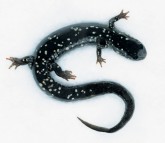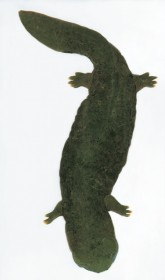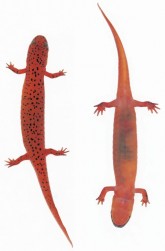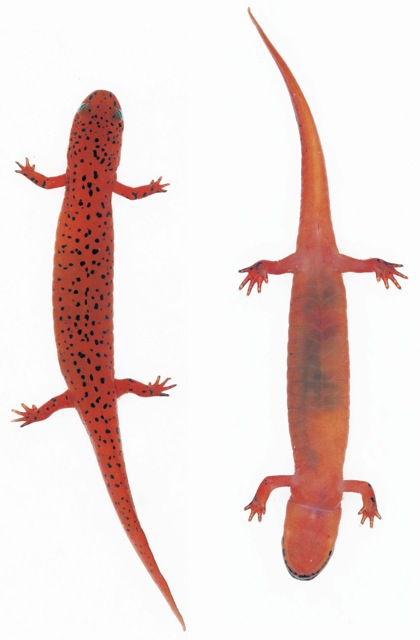Selected salamander portraits by Brandon Ballengée and Stanley Sessions, organized by Amy Lipton
January 11 – March 16, 2013
SALAMANDER is the common name for about 550 species of Amphibians with tails. They include all the members of the order Caudata, which includes newts, sirens, mudpuppies, olms, amphiumas, hellbenders and others. The name Salamander is derived from an old Arab/Persian word meaning “lives in fire”, stemming from an old belief, false of course, that the salamander could walk through fire and remain unharmed. This myth may have originated from the bright skin colors resembling flames that some salamanders have.
Salamanders are extraordinary survivors and have been on this earth for over 160 million years! Over the last 50 years, over 200 species of amphibians throughout the world have declined markedly in numbers with reports of 32 species extinctions. In many instances, these declines are attributable to adverse human influences acting locally, such as deforestation, draining of wetlands, and introduced species. Salamanders are important animals in our world, not only because they are fascinating and beautiful, but also because they serve as warnings of environmental stress: essentially functioning as Ecological alarms. Amphibians are very sensitive to their environments and populations begin to decline when the balance of their habitat is disrupted.
Since 1998, Stanley and Brandon have collaborated on art and science collaborations (both as artists and biologists in their own right). A central focus of their collaborative efforts has been to create amphibian themed artworks to inspire viewers to learn more about these fascinating creatures. Likewise an underlying conceptual mission is to increase public awareness and understanding of biological phenomena and environmental concerns while challenging viewers both aesthetically and intellectually. With through their scientific collaborations they have made important discoveries about the reasons for developmental deformities among wild populations of amphibians, such as parasitic infection and predatory injury. These salamander “portraits” were made as part of their Rockefeller Foundation Fellowship at the Institute for Electronic Arts, School of Art and Design New York State College of Ceramics at Alfred University, Alfred, New York during 2000 through 2001. They have shown these works nationally and internationally including exhibitions in Canada, China, England, Italy and elsewhere.
Brandon Ballengée, Professor, School of Visual Arts, New York, NY. Ballengée explores boundaries between art, science and technology and creates multidisciplinary works generated from field trips and research. Ballengée has exhibited internationally at the Centro d’Arte Contemporanea, Torino, Italy, and in a solo exhibition at Ronald Feldman Fine Arts in NYC.
Stanley K. Sessions, Professor, Department of Biology, Hartwick College, Oneonta, NY. Sessions’ expertise is in evolutionary and developmental biology. He teaches Animal Development, Evolution, Natural History of Vertebrates, and Developmental Genetics plus an off-campus course on the Natural History of Costa Rica. His research interests include developmental and cytogenetic studies in amphibians, with recent focus on the natural causes of amphibian deformities.






